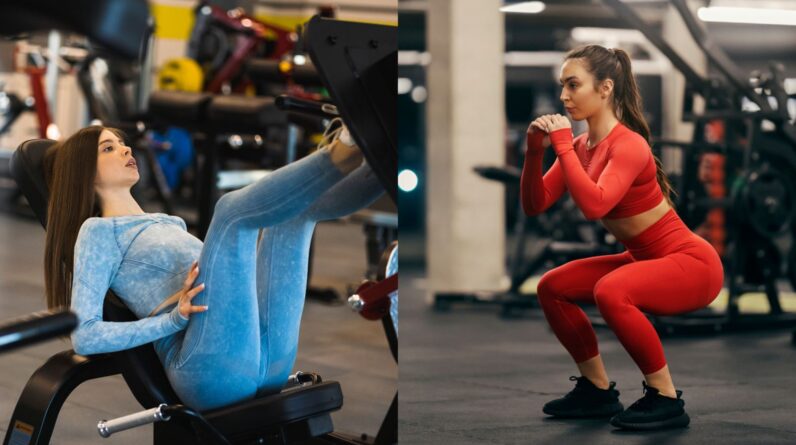
Leg press vs squats: While both exercises offer a plethora of benefits, is one better than the other for increasing lower body strength and boosting calorie burn? Let us find out.
Leg presses and squats are two of the go-to moves in pretty much every workout session. Both are fantastic for targeting several leg muscles, such as the quadriceps, glutes, hamstrings, and calves. On one hand, squats, a compound movement, engage multiple muscle groups and promote overall functional strength and balance. On the other hand, leg presses include pushing heavy weight through the legs, which not only builds leg muscles but also targets the core. But have you ever wondered which one will truly fire up your lower body muscles and burn calories – leg press or squats? Let’s help you figure it out.
Leg presses vs squats: The difference
While both leg presses and squats are effective lower-body exercises that primarily work your quadriceps or quads, they are still different from each other and offer different benefits.
Leg press
The leg press is a lower body strength exercise that is performed on a machine where you push a weighted platform away with your legs. This primarily targets large lower-body muscle groups such as quadriceps, hamstring, gluteus, and gastrocnemius, as per a study published by the International Journal of Environmental Research and Public Health. It offers more stability and isolates the leg muscles. Here’s how to perform leg press:
- Sit on the machine with your back against the pad and feet placed shoulder-width apart on the platform.
- Adjust the seat so that your knees are at a 90-degree angle.
- Push the platform away by extending your legs (but do not jerk), keeping your feet flat and your knees aligned with your toes.
- Slowly return to the starting position by bending your knees.
- Avoid locking your knees at the top and maintain controlled movement throughout the exercise.

Squat
Squats are a compound exercise that can be done in many ways. However, a standard squat involves lowering your body into a seated position by bending your knees and then returning to a standing position. According to a study published in the Journal of Sports Science and Medicine, squats primarily target muscles around the core, back, hips, buttocks, and legs and can help with burning fat and promoting weight loss. Squats require balance and coordination, providing a more functional full-body workout and improving core strength. Here’s how to perform squats:
- Stand with feet shoulder-width apart and toes slightly turned out.
- Keep your chest up and your back straight.
- Bend your knees and lower your body as if sitting back in a chair, ensuring your thighs are parallel to the ground or slightly below.
- Keep your weight on your heels and knees.
- Push through your heels to return to the starting position.
- Maintain a controlled pace and avoid letting your knees move inward.
Squat vs deadlift: Which one is a better exercise for strength?
You may also like



Pros and cons of leg press
Pros:
1. Lower body strength: Leg press exercises target quadriceps, hamstrings, and glutes effectively, helping build muscle mass and lower body strength.
2. Controlled movement: You perform leg press in a controlled way, which helps reduce the risk of injury compared to weighted squats.
3. Easy to perform: It is very easy to adjust the weight and perform this exercise.
4. Less load on the spine: Since the leg press machine provides back support, it causes less strain on the lower back, making it beneficial for those with back issues.
Cons:
1. Cannot be performed without equipment: Unlike squats, which require no equipment, leg press requires access to a specific machine, which may not always be available.
2. Strain one leg: The machine will move the same way whether both legs are pushing equally or only one leg is putting in extra effort. This may cause one leg to work harder than the other.
3. Risk of injury: If you press too much weight or lock your knees when extending your legs, you may end up causing a knee injury.
Pros and cons of squats
Pros:
1. Builds strength: Squats target multiple muscle groups, including the quadriceps, hamstrings, glutes, and lower back, enhancing overall strength and muscle tone.
2. Improves functional fitness: Squats mimic natural movements (standing or bending), which helps improve balance, stability, and mobility beneficial for daily activities.
3. Boosts metabolic rate: Squats engage large muscle groups, which can elevate heart rate and boost calorie burn, aiding in weight management.

Cons:
1. Risk of injury: Poor form or holding excessive weight while performing squats can lead to knee, lower back, or shoulder injuries. Make sure you follow a proper technique.
2. Stress on joints: Squats can place significant stress on the knees and hips. So, it is not advisable to perform it if you have pre-existing knee problems, such as arthritis.
9 exercises to tone your legs and strengthen the lower body
Leg press vs squats: Which one is better?
Both leg presses and squats are great exercises but they offer different benefits and drawbacks. Squats are a compound exercise that engages multiple muscle groups, including the quadriceps, hamstrings, glutes, and core. Squats can be performed in different ways, with or without weights.
Whereas leg presses are a more isolated exercise focusing primarily on the quadriceps, hamstrings, and glutes, they do not target the core or hip muscles. It is a more beginner-friendly exercise. However, it still allows you to lift heavy weights and target all leg muscles.
If you are looking for an overall body workout, then squats have the advantage over leg presses. But if balance is a problem or you have shoulder or back pain, then leg presses may be a better choice. However, squat is a better exercise than leg press if you want to build lower body strength and burn calories due to the higher energy expenditure required to perform the movement. Also, you should keep it in mind that spot reduction is a myth so you have to make these exercises a part of your overall workout as they may not benefit you if done interdependently.







